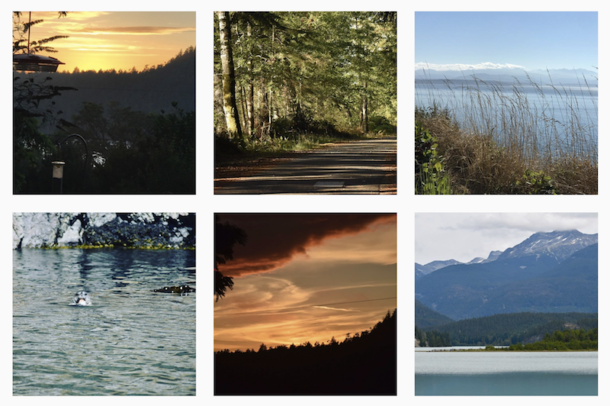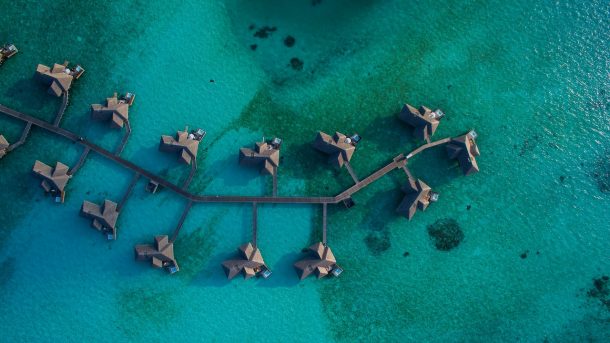Have you been curious about a zen retreat, such as meditating at Upaya or perhaps visiting Tibet?
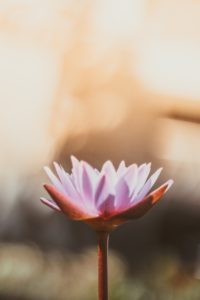
Photo credit: Ahmed Saffu, Unsplash
Images of smiling Buddhist monks, flowing robes and the sounds of beautiful bells probably come to mind. Chirping birds, beautiful pathways, flowers and fresh air.
And silence, as the monks pursue their tasks and meditate.
The Buddists use meditation as part of their quest for enlightenment. Meditation has no religious overtones. Like its counterpart mindfulness, it is simply about being still and quiet in this busy world. The benefits of stopping to be still can be considerable.
It was the healing aspects of meditation coupled with a need to manage stress and life with cancer that caused me to start exploring this path. Learning to meditate and incorporating its benefits into my daily routine has changed my life.
Someone recently asked me about meditation and why I found it so powerful. Let me try to conjure up an analogy:

The yin and yang of black and white
First, imagine you only see white.
Think of white as the constant noise of TV, conversations, life in general. In white there are market lists, to do lists, thoughts about the past and the future. Your mind jumps from topic to topic, conversation to conversation, past to future. The mental buzz is unending. It’s society’s matrix and its probably where you spend most of your time.
Now introduce black.
There is stillness.
There are no lists or noise, no distractions or requirements, no past or future.
Just stillness. You feel the peace and serenity.
Pause and consider that for a moment.
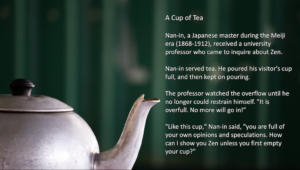
The Zen Koan, A Cup of Tea
In peace, in the absence of (psychological) time, there are no thoughts. The quiet you find is extraordinary. Revolutionary. Game changing.
Observe your thoughts. Let them fall away.
At first this stillness may be elusive, but with practice, you can learn to take it with you, wherever you go.
The trick is navigating the external matrix without losing the internal stillness.
So it is that meditation is part of my daily routine. And this Sunday I joined a half day “sit” at Upaya, called “The Ease and Joy of Mornings”.
Upaya is a well known zen monastery and retreat in the hills above Santa Fe. It is accessed via an un-prepossessing, unpaved road. Clouds of dust rise as a car passes and a dirt driveway appears dropping off steeply to the right.
Welcome to Upaya
Click here to visit the Photo Gallery!
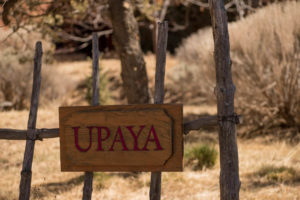
A simple sign outside the Zen monastery greets the visitor
A friend had invited me to three hours of Zazen (sitting meditation) broken with intervals of Kinhin (Walking Meditation). Meetings are held in the zen-dō, a spiritual dōjō where meditation is practiced.
This was my first Zen “sit” and I approached it with curiosity and the hope that a three hour session won’t be too much for my chemo joints or my sometimes busy mind.
The word “Zen” derives from the Sanskrit word “dhyana” which translates into “meditation” or “absorption.” In Chinese, the word is “Chan”; in Japanese, “Zen”.
Zen is a form of Buddhist meditation—there is nothing to believe in, and nothing special to do or be. One need not wear robes or shave one’s head. One is simply present.
Upaya Institute and Zen Center is one of several Buddhist monasteries in the area. It’s not a fancy place. The accommodations at the monastery are, well, monastic.
On the surface, the monastery and Zen Center radiant peace, but a brief look at the schedule shows what a culturally and intellectually dynamic place Upaya is.
On the peaceful side of the equation, daily meditations are open to the public at 7:00 am, 12:20 pm and 5:30 pm and one is warmly welcomed.
On the intellectual and cultural side of the equation, Upaya simply rocks. Weekly talks and programs on topics ranging from Buddhist teachings to art, neuroscience and other topics are offered to anyone who would like to attend. Wednesday evening Dharma talks are also open to the public.
But my interest this day is on experiencing an extended morning of meditation at this beautiful retreat.
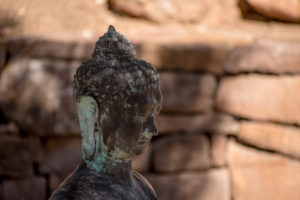
A mediating statue outside the entrance to the zendo
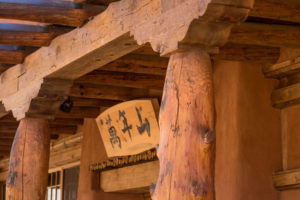
The entry to the Upaya zendo or meeting hall.
The atmosphere is kind, open and friendly. A good number of participants this morning were newbies like myself. In addition to cushions, chairs are placed along the wall, should sitting for extended periods be difficult. Many of us choose a chair, myself included.
Petra Hubbeling from Holland leads the group. She visits Upaya twice a year, for three months each visit. Her background of thirty years in business recruitment and management is in contrast to her current life in training a student in Upaya’s Chaplaincy Program. She reflects on her first visit:
“Being at Upaya that first time, I felt how every guest practitioner who comes here feels. I fell in love with this place, with the beauty of the center, with the beauty of the practice, with Upaya’s deep commitment to social engagement.”

Light spills through the window into the sunroom
Petra outlines the morning agenda, explaining some of the monastery’s traditions, and we settle in to meditate in silence until the soft resonance of the gong sounds. About forty minutes, I would guess. Time does not matter. One of the apprentices is tasked with monitoring the clock. Our only task is to be present in our meditation.
“Real Zen is the practice of coming back to the actual right-now-in-this-moment self, coming back to the naturalness, the intimacy and simplicity of our true nature. Zen practice is not about getting away from our life as it is; it is about getting into our life as it is, with all of its vividness, beauty, hardship, joy and sorrow. Zen is a path of awakening: awakening to who we really are, and awakening the aspiration to serve others and take responsibility for all of life”. -Upaya website
The sound of the gong wafts gracefully through the zendo and indicates it is time to move from our still minds to our bodies, all in silence except for some instruction from Petra. We bow first to our place of meditation, then to the room. And single file, we start to walk.
“Fast, faster”, Petra beckons. “Follow the person before you. Move as they move.”
The pace quickens and the human line weaves through the zendo, into the sunroom and back.
“Now walk slowly.” The cadence changes. “Align your movement with the person in front of you. Follow your breath.”
Now the entire human line slows, in step with each breath. Each movement is exaggerated with great awareness. From heal to toe and back again. Slowly. The goal is to have the entire line move as one, with a collective awareness of each move.
We weave in a line from the zendo to the sunroom and back. The room moves as one and we return for another period of Zazen followed by another period of Kinhin . Then we break for some tea and snacks in the kitchen.
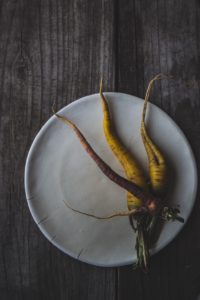
Photo Credit: by Nathan Burrows on Unsplash
The kitchen is busy and welcoming, as students mindfully chop vegetables, cook meals, wash dishes and sweep the floor. Off the kitchen, there is a smaller indoor dining area a step down, for daily dining. There is also a long patio overlooking the grounds for larger groups. We gather here until returning to the zen-dō for a discussion about the traditions of this morning sit.
Upaya was founded in 1994 by Roshi Joan Halifax, PhD. This remarkable woman is a Buddhist teacher, Zen priest, anthropologist, and a pioneer in the field of end-of-life care. She has been an Honorary Research Fellow at Harvard and a Distinguished Visiting Scholar at the Library of Congress.
Professionally and spiritually, she has focused on the psycho-social, ethical and spiritual aspects of care of the dying, particularly with cancer patients. Her influence on the field of spirituality, medicine and compassion cannot be overstated.
I have to say I am humbled, amazed and grateful to have access to such an amazing educational and cultural institution in my back yard.
The upcoming Upaya schedule for this Spring includes programs such as Rediscovering Zen’s Roots in Ancient China by philosopher and Columbia University teacher David Hinton; and a two week Japan Arts Pilgrimage, Ancient and Contemporary Art and Sacred Sites, with Roshi Joan Halifax. A full schedule of events is here.
Upaya is just one of several Zen monasteries in Santa Fe. While I’m taken with this incredible zen center, I also look forward to exploring the others. I think my interest lies in the wonderful ambiguity associated with the Buddhist train of thought, along with my already established meditation practice. I don’t see myself running off to a monastery (too many restaurants to discover!), but I am drawn to the recognition of impermanence that we all seem to seek to avoid.
In the words of the 8th-century Buddhist master Shantideva (The Way of the Bodhisattva):
All that I possess and use
Is like the fleeting vision of a dream.
It fades into the realms of memory;
And fading, will be seen no more.
–Tricycle: The Fundamental Ambiguity of Being Human
Click here to visit the Photo Gallery!
If you’re interested in some reading on meditation and mindfulness:
This is the first book I recommend to everyone curious about meditation. The author asks you to set aside just 8 minutes a day. Week by week, he introduces new approaches to meditating. It gives you the chance to sample some different bodies of thought and decide which–if any– might suit you. An excellent place to start, and one of my first books as well!
The Power of Now is one of the most amazing books ever. Eckhart Tolle’s personal story takes him from homelessness to spiritual teacher.
From Amazon:
“To make the journey into the Now we will need to leave our analytical mind and its false created self, the ego, behind. From the very first page of Eckhart Tolle’s extraordinary book, we move rapidly into a significantly higher altitude where we breathe a lighter air. We become connected to the indestructible essence of our Being, “The eternal, ever present One Life beyond the myriad forms of life that are subject to birth and death.” Although the journey is challenging, Eckhart Tolle uses simple language and an easy question and answer format to guide us.
A word of mouth phenomenon since its first publication, The Power of Now is one of those rare books with the power to create an experience in readers, one that can radically change their lives for the better.”
If you haven’t read this, download it NOW! It’s one of those books you’ll come back to again and again.
This book is a classic for a reason. It’s about integrating mindfulness meditation into everyday life. It’s been updated with a new afterward by the author.
More Posts about Zen and Travel:
Winter Zen in Santa Fe: Upaya and Ojo Caliente
Thoughts on the Metaphor of a Road trip
11 Life Lessons Learned From the Road
Traveling the Timeline of Now
Travel Packing List: Quotes, Wisdom and a Minimum of Luggage
Travel Minimalist: 17 Reasons Why Less is More
Reflections on Life With Cancer
Aparigraha
Like This Post? Pin It!
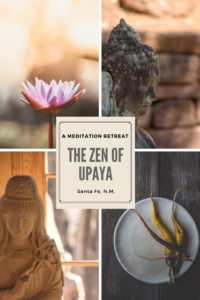
If you’re interested in learning more about photography (or cooking or film or any number of topics) check out Masterclass for on-line excellence:
What is #CancerRoadTrip and how did it come to be? Read this post to get the backstory!
Follow me on Twitter, Pinterest, Instagram, and at Anti-Cancer Club. Connect with me! I may need a place or two to stay along the way!





